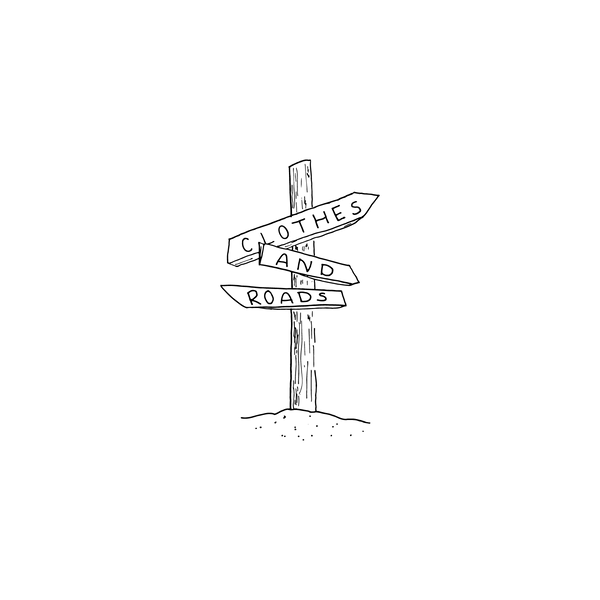FREE SHIPPING in Canada on orders $150 + 📦 Online orders placed after December 18 will ship starting January 5
FREE SHIPPING in Canada on orders $150 + 📦 Online orders placed after December 18 will ship starting January 5
Shop

7 Ways to Create a Sustainable and Socially Conscious Wardrobe
by Marie-Eve Bournival-Paré July 27, 2023 5 min read
The clothes we choose to wear are a form of self-expression and a source of comfort as we go about our daily routine and milestone moments in our lives. But what if we could do more with our wardrobe—for the planet and for our communities—simply by being intentional in our choices?
Fast fashion has us shopping impulsively, chasing seasonal trends and styles without thinking much about our choices. Everything in fast fashion happens at an alarming pace—production is fast, delivery is fast, change is fast. Trends become obsolete before we’ve even had time to wear out our clothes. Sadly, fast fashion has a negative impact on our planet. The fashion industry produces 8-10% of global carbon emissions1 and nearly 20% of wastewater annually2.
To counter the environmental footprint of fast fashion and improve workers’ rights, the slow fashion movement promotes mindful consumerism and more transparent manufacturing practices.
Creating a sustainable and socially conscious wardrobe doesn’t happen overnight. For some, the shift in mindset can even feel daunting. It takes a certain level of commitment to make the switch from fast to slow fashion.
At Clothes & Roads, we are firm believers that dressing sustainably does not mean having to compromise on comfort or design! Here are our 7 tips on creating a conscious closet that reflects both your style and your values.
1. Think about wearability
The greenest garment is not actually sustainable at all if it’s stuffed in a drawer or at the back of your closet. You have to actually wear an item (and much more than just once!) to make it truly sustainable. This is why it’s important to veer away from highly trendy or statement pieces that tend to go out of style quicker than you can say “fast fashion”. Choose clothes you really love. If you try it on and think “maybe”, chances are your answer should be “no”.
Focus on timeless pieces that outlast any passing fad. Bonus points if you can wear it year-round by combining it with other layers or seasonal accessories! Remember, even eco-friendly fashion creates pollution, so make it worth it. Aim for longevity.
A little care for your clothing goes a long way. Be sure to follow washing instructions and to repair items rather than discarding them. If a zipper breaks, try to get it fixed before hitting the mall.
2. Reduce the environmental impact of laundry
We may not think about it, but getting things clean and fresh actually hurts the planet! The way we use and wash our clothes accounts for 38% of a garment’s environmental impact3. Thankfully, it’s an area in which we have control, as we can be more thoughtful in the ways we wash, dry, iron and care for our clothing. If your nose agrees, wear an item a few times before tossing it in the hamper (or on the floor…hey, we’re not here to judge!). Wait until you have a full load to do a wash.
Choose non-chemical detergents; not only do chemical detergents pollute the water (which ultimately contaminants our soil and the food we eat), these detergents are harsh on our clothes, thus affecting their longevity. Wash at a low temperature and hang your clothes to dry rather than consuming extra energy with the dryer. If possible, invest in an eco-friendly washing machine or choose the eco setting if your machine has one. Skip the ironing by choosing fabrics wisely. Our clothes are made of bamboo rayon, organic cotton, linen, hemp, and merino wool, which are breathable, low-maintenance and quick to dry.
Learn more in our blog post: 7 TIPS TO REDUCE THE ENVIRONMENTAL IMPACT OF YOUR LAUNDRY.
3. Invest in quality over quantity
Versatility is your best friend. In addition to reducing its “cost per wear”, having one versatile item in your closet versus 10 non-versatile items is a much more environmentally conscious approach. Invest in a few high-quality pieces rather than collecting tons of cheaper, less eco-friendly ones.
4. Be informed about ethics
An ethical wardrobe paves the way for a greener wardrobe. Do your homework on brands and make sure you are buying from brands that align with your values. Read up on their ethics, materials and production processes. If you can’t find their stance on their website or social media, contact them and ask for clarifications. It is your right as a consumer! Check the tag to see where the garment was made and do some research on working conditions in that country. Are workers treated and paid fairly? Follow the Who Made My Clothes movement. They stand for workers’ rights and advocate for transparency so consumers can make informed choices about the fashion they buy. The movement holds brands accountable for their manufacturing practices and makes a Fashion Transparency Index available for consultation.
For more tips, check out our blog post: HOW TO TELL IF CLOTHING IS ETHICALLY MADE.
5. Shop small and shop local
Shopping local not only encourages your own economy, but it also helps limit pollution at every step between the product’s creation and delivery to the customer’s doorstep. Plus, you ensure that the person who made your garment has been fairly compensated and treated according to the standards imposed by labor laws. The best part about shopping local is getting to meet the maker at events where they may be exhibiting! Visit your favorite brands at their booth and ask them any questions you might have about sustainability and how they reduce their environmental footprint.
Our booth at Salon des métiers d'arts de Montréal at the Olympic Stadium in December 2022.
6. Choose sustainable fabrics
We already mentioned that the key to sustainability is longevity. Comfort is highly subjective; it’s important to know your needs and preferences to choose clothing items that will remain your favorites for a long time. Opt for durable fabrics that stand the test of time and are easy to maintain. Some fabrics are also more eco-responsible than others. Organic cotton, for example, is grown without the use of GMO seeds, synthetic fertilizers, toxic pesticides or insecticides. Merino wool and tencel are biodegradable. Modal fabric is derived from Beechwood trees sourced from sustainable forests. Recycled polyester is made from post-consumer plastic waste saved from landfills. Get to know your fabrics and choose ones that feel good for your skin and for the planet!
Learn more about Clothes & Roads fabrics and their benefits here.
7. Declutter and donate often
A happy wardrobe is one that is well loved. It may initially feel daunting and limiting to create a capsule wardrobe, but once you see that less is more, you won’t turn back! Declutter your wardrobe and give your clothes a second or third life as often as you can! When items are still in good condition but not quite you anymore, don’t shove them into a bin under your bed or into the garbage. Instead, pass them on and extend their life. Donating clothes avoids them piling up in a landfill.
Shopping and dressing sustainably doesn’t have to feel limiting. An ethical and minimalist approach to fashion can make you feel lighter and happier. At Clothes & Roads, slow fashion and transparency matter to us. You can read more about our commitment to slow fashion and our eco-conscious practices that reduce waste in production and packaging, as well as every step in between!
Shop our minimalist reversibles, timeless classics and sustainable fabrics in our shop.
Don’t forget to tag us on social media @clothesandroads to show us your favorite eco-conscious apparel!
Sources:
[1] Leal Filho, W., Perry, P., Heim, H., Dinis, M. A. P., Moda, H., Ebhuoma, E., & Paço, A. (2022). An overview of the contribution of the textiles sector to climate change. Frontiers in Environmental Science, 1419.
[2] Morlet, A., Opsomer, R., Herrmann, S., Balmond, L., Gillet, C., and Fuchs, L. (2017). A new textiles economy: Redesigning fashion’s future. Ellen MacArthur Foundation.
[3] FAIR'ACT, « Cycle de vie d'un t-shirt »
Marie-Eve Bournival-Paré
Hi! I am the designer and founder of Clothes & Roads, I love tea, succulent plants, yoga, chocolate and baby animals. Between designing new clothes for my brand, managing my social accounts, the production and the business finances, I like to share on the blog a diversity of subjects like slow fashion, travel, zero waste, local products, minimalism and vanlife! 🚐
Leave a comment
Comments will be approved before showing up.
Also in Blog

Who Made My Clothes? 9 Facts About the Creator of Clothes & Roads
by Marie-Eve Bournival-Paré April 22, 2025 6 min read
April marks Fashion Revolution Month, a global movement that encourages consumers to ask the question: Who made my clothes? It’s an opportunity to highlight the people and processes behind ethical, transparent, and sustainable fashion. In this spirit, I thought I’d share a few facts about myself so you can get to know the creator behind Clothes & Roads and learn a bit about my slow fashion journey. So here are 9 fun facts about me!

Practical Guide: How to Make the Most of Your Craft Market Shopping Experience
by Marie-Eve Bournival-Paré March 12, 2025 5 min read
Visiting a craft market can be a wonderful experience but planning your visit in advance is key to making the most of it. This practical guide helps you optimize your experience so you can shop with intention while supporting local makers. Read on to make the most of your next craft fair visit!

Five Things I Love About Craft Markets: The Benefits of Shopping from Small Businesses and Local Designers
by Marie-Eve Bournival-Paré March 12, 2025 5 min read
As the designer and manufacturer behind Clothes & Roads, I attend craft markets to showcase my handmade eco-conscious minimalist apparel. Being part of these exhibitions is always such a highlight for me as a business owner. But beyond participating as an artisan, I also love exploring craft shows as a visitor. There’s something so inspiring about wandering from booth to booth, meeting other makers, and discovering beautiful, locally made artisanal products. Craft markets are such a unique way to connect with the small business community and celebrate diversity in creativity.
Discover five things I love about craft fairs.
Recent Articles
- Who Made My Clothes? 9 Facts About the Creator of Clothes & Roads
- Practical Guide: How to Make the Most of Your Craft Market Shopping Experience
- Five Things I Love About Craft Markets: The Benefits of Shopping from Small Businesses and Local Designers
- 7 Steps for a Successful Craft Show: How my apparel shop prepares for craft fairs
- Your 2024 Favorites at a Glance: Our Bestsellers
- Stay Cool and Comfortable with Our Thigh-Length Anti-Chafing Bamboo Women’s Boxer: The Ultimate Summer Must-Have
- Let’s talk zero waste and the fashion industry
- What Is a Capsule Wardrobe and Why Should You Have One?
- 7 Ways to Create a Sustainable and Socially Conscious Wardrobe
- 6 Timeless and Ecofriendly Basics Every Capsule Wardrobe Should Have
Subscribe
Wanderlust. News. Sales. Rewards, and more.
Subscribe to our newsletter and get 10 % off your first purchase.

Get on board !
Wanderlust. News. Sales. Rewards, and more.
Subscribe to our newsletter and get 10 % off your first purchase.
Net Orders Checkout
| Item | Price | Qty | Total | |
|---|---|---|---|---|
| Subtotal |
$0.00 |
|||
| Shipping | ||||
| Total | ||||



